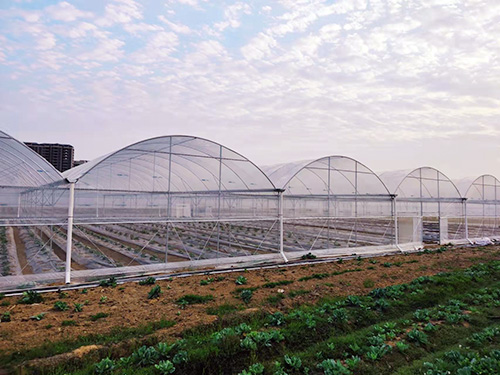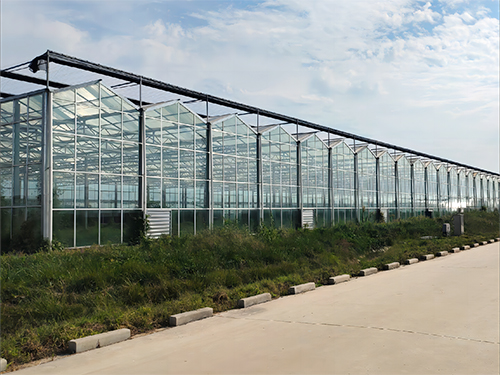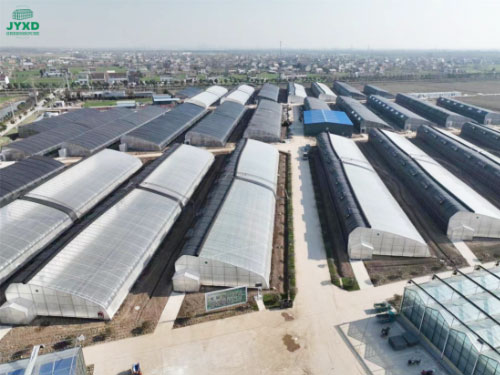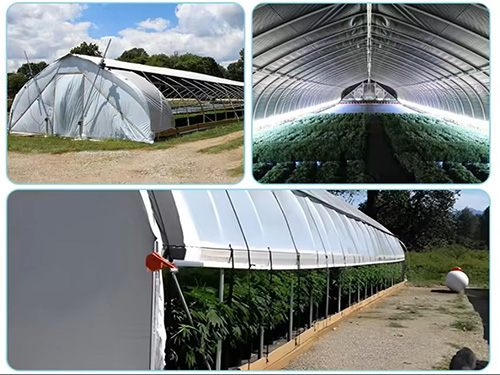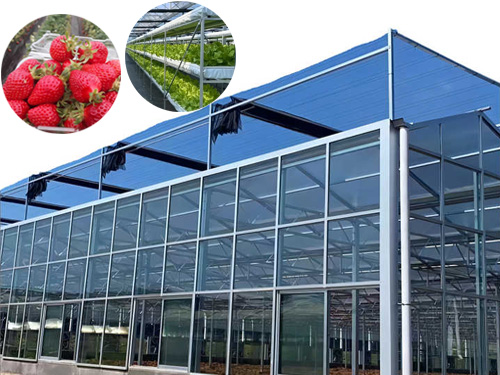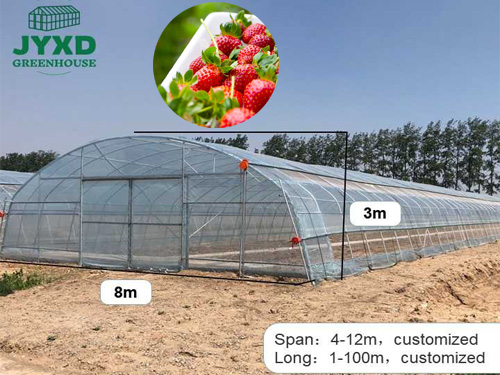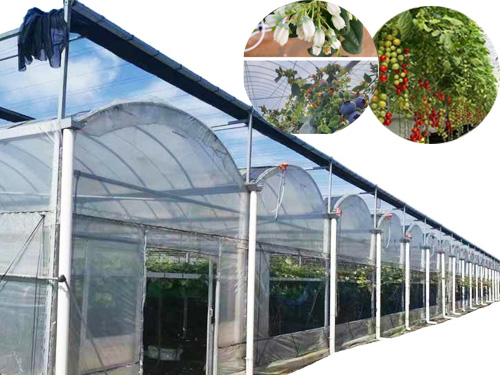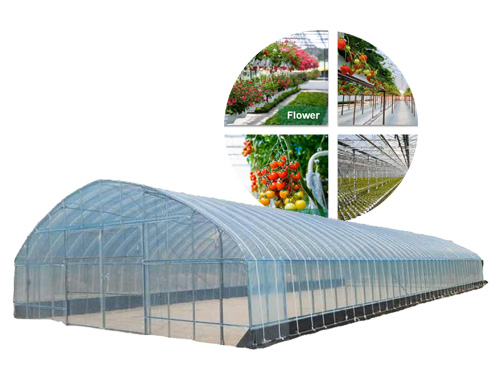NEWS DETAILS
NEWS INFORMATION
Anti Drip Greenhouse Film: Enhancing Your Greenhouse with Advanced Moisture Control
AUTHOR:jyxd-greenhouse DATE:2024-12-02 00:14:59 HITS:147
When it comes to growing crops in greenhouses, maintaining the right environment is essential for ensuring plant health and maximizing yield. One of the most common problems greenhouse growers face is the accumulation of water droplets on the interior surfaces of greenhouse films, which can fall onto plants and cause several issues like disease and mold. This is where anti-drip greenhouse film comes in. In this article, we’ll explore what anti-drip greenhouse film is, how it works, its benefits, and why it is an essential addition to your greenhouse setup.
What is Anti Drip Greenhouse Film?
Anti-drip greenhouse film is a specialized plastic film designed to reduce the formation of water droplets on the inside surface of greenhouse coverings. This film is coated with a special layer that prevents condensation from forming large water droplets, allowing moisture to spread evenly and evaporate naturally. Instead of dripping onto plants, the moisture remains on the film’s surface in a thin, uniform layer, which greatly reduces the risk of water-related plant diseases and damage.
The main difference between anti-drip films and traditional greenhouse films is that anti-drip films feature a treatment that minimizes the chance of water droplets accumulating. These films are commonly used in both commercial greenhouses and home gardening setups, helping to create a more controlled, healthy growing environment.
Keywords: anti-drip greenhouse film, greenhouse film moisture control, condensation prevention film
How Does Anti Drip Greenhouse Film Work?
Anti-drip greenhouse films work through a unique coating or surface treatment that changes the way moisture interacts with the film. Here’s how they function:
1. Coating Technology
Anti-drip films are often treated with a hydrophilic (water-attracting) coating that ensures the moisture does not form into droplets. This coating causes the water to spread evenly across the film's surface, creating a thin, consistent layer of moisture. As a result, the film doesn't allow large water droplets to form and fall onto plants, which would otherwise promote mold and disease.
2. Capillary Action
Some anti-drip films also rely on capillary action, which helps moisture flow evenly over the film. This method ensures that water doesn’t pool in one area but is evenly distributed, promoting better moisture management throughout the greenhouse.
3. Evaporation Efficiency
Instead of allowing moisture to condense and fall onto plants, the uniform moisture layer helps with evaporation, keeping the greenhouse environment more balanced. This ensures that the internal humidity levels are regulated, benefiting plant health and productivity.
Keywords: hydrophilic coating, capillary action, moisture distribution
Benefits of Using Anti Drip Greenhouse Film
Adopting anti-drip greenhouse film in your setup can offer a variety of benefits that improve both the environment and crop quality. Here are some key advantages:
1. Prevents Water Droplets on Plants
The most significant benefit of anti-drip greenhouse film is the prevention of water droplets falling onto plants. Droplets can encourage the growth of mold, mildew, and fungi, which can harm plants. By spreading moisture evenly across the film’s surface, the risk of plant diseases is greatly reduced, leading to healthier crops.
2. Reduces the Risk of Fungal Infections
Moisture accumulation on plant leaves creates the perfect breeding ground for fungal infections. With anti-drip film, moisture is controlled, and the likelihood of these infections is reduced, helping to keep crops free from diseases like powdery mildew or botrytis, which are often caused by excessive humidity and moisture.
3. Improves Light Transmission
Unlike traditional greenhouse films that may become cloudy from condensation, anti-drip films maintain a clearer surface. With minimal water droplets or fogging, these films allow more sunlight to penetrate, which is crucial for photosynthesis and healthy plant growth. As a result, plants receive more consistent and optimal light exposure.
4. Maintains Consistent Humidity
Maintaining the right humidity level is essential for plant growth, but excessive humidity can cause problems. Anti-drip greenhouse films help control moisture in the air and on the film surface, leading to a more stable internal environment. This consistent humidity prevents both drought stress and excess moisture, creating the perfect balance for plants.
5. Energy Efficiency
Anti-drip films also have energy-saving benefits. Because they help maintain optimal temperature and humidity levels inside the greenhouse, they can reduce the need for additional heating or cooling systems. This results in lower energy consumption, which not only benefits the environment but also reduces operational costs.
Keywords: prevents water droplets, reduces fungal infections, improves light transmission, consistent humidity, energy efficiency
Applications of Anti Drip Greenhouse Film
Anti-drip greenhouse film can be used in a variety of settings and for different types of crops. Here are some of the key applications:
1. Commercial Greenhouses
In large-scale commercial greenhouse operations, maintaining a controlled environment is critical. Anti-drip film helps prevent water from dripping onto plants, reducing the risk of diseases, and improving overall crop quality. It's particularly useful for high-value crops like tomatoes, cucumbers, and flowers, where water droplets can have a significant negative impact on yields and plant health.
2. Home Gardening and Hobby Greenhouses
Home gardeners and hobbyists can also benefit from anti-drip greenhouse films. Smaller greenhouses often have less airflow and ventilation, making condensation a more significant issue. By using anti-drip film, hobbyists can maintain a healthier, cleaner growing environment for their plants.
3. Hydroponic and Aquaponic Systems
In hydroponic and aquaponic systems, where water is often used in various forms, moisture control becomes even more crucial. Anti-drip greenhouse films can help maintain a stable environment by preventing excess water from forming on the film's surface, which might otherwise lead to waterlogging or fungal growth in these delicate systems.
Keywords: commercial greenhouses, home gardening greenhouse, hydroponic greenhouses
How to Install Anti Drip Greenhouse Film
Installing anti-drip greenhouse film is a straightforward process. Here are some basic steps to help ensure a successful installation:
1. Measure Your Greenhouse
Measure the length and width of your greenhouse to determine how much anti-drip film you need. Ensure you account for any edges or overlaps when covering the structure.
2. Prepare the Frame
Clean the greenhouse frame and check for sharp edges that could damage the film. Ensure the frame is sturdy enough to support the new film.
3. Cut the Film to Size
Once you have the appropriate size of anti-drip film, cut it to fit your greenhouse. Leave extra material on all sides for secure attachment.
4. Install the Film
Carefully roll the film over the greenhouse frame, making sure it is taut and smooth. Secure the film with clips, ropes, or specialized greenhouse film fasteners.
5. Check for Proper Sealing
After installation, ensure there are no gaps where moisture could enter or escape. Proper sealing will help maintain the greenhouse’s internal environment and ensure the anti-drip film performs effectively.
Keywords: anti-drip film installation, greenhouse film installation
Conclusion
Anti-drip greenhouse film is a highly effective tool for greenhouse growers looking to control moisture and prevent water droplets from forming on plant leaves. With benefits such as reduced risk of fungal infections, improved light transmission, consistent humidity levels, and energy efficiency, this specialized film is an essential component for creating the optimal environment for plant growth.
Whether you're managing a commercial greenhouse or a smaller hobby greenhouse, anti-drip greenhouse film provides a practical, cost-effective solution for maintaining plant health and increasing crop yields. By investing in this innovative film, you’ll not only enhance the environment inside your greenhouse but also improve the long-term success of your growing operation.
Keywords: anti-drip greenhouse film, greenhouse moisture control, plant disease prevention, greenhouse energy efficiency, anti-drip film installation
Hebei Juyou Xinda Greenhouse Facilities Co.,Ltd.
Copyright © 2024-2025 https://www.jyxd-greenhouse.com. All Rights Reserved Hebei Juyou Xinda Greenhouse Facilities Co.,Ltd.Copyright





 Current Location:
Current Location: